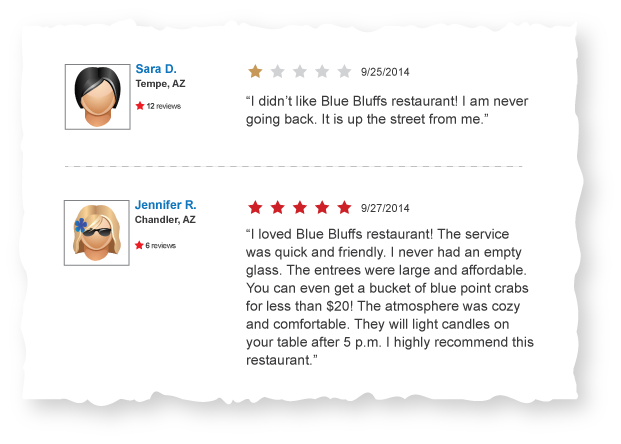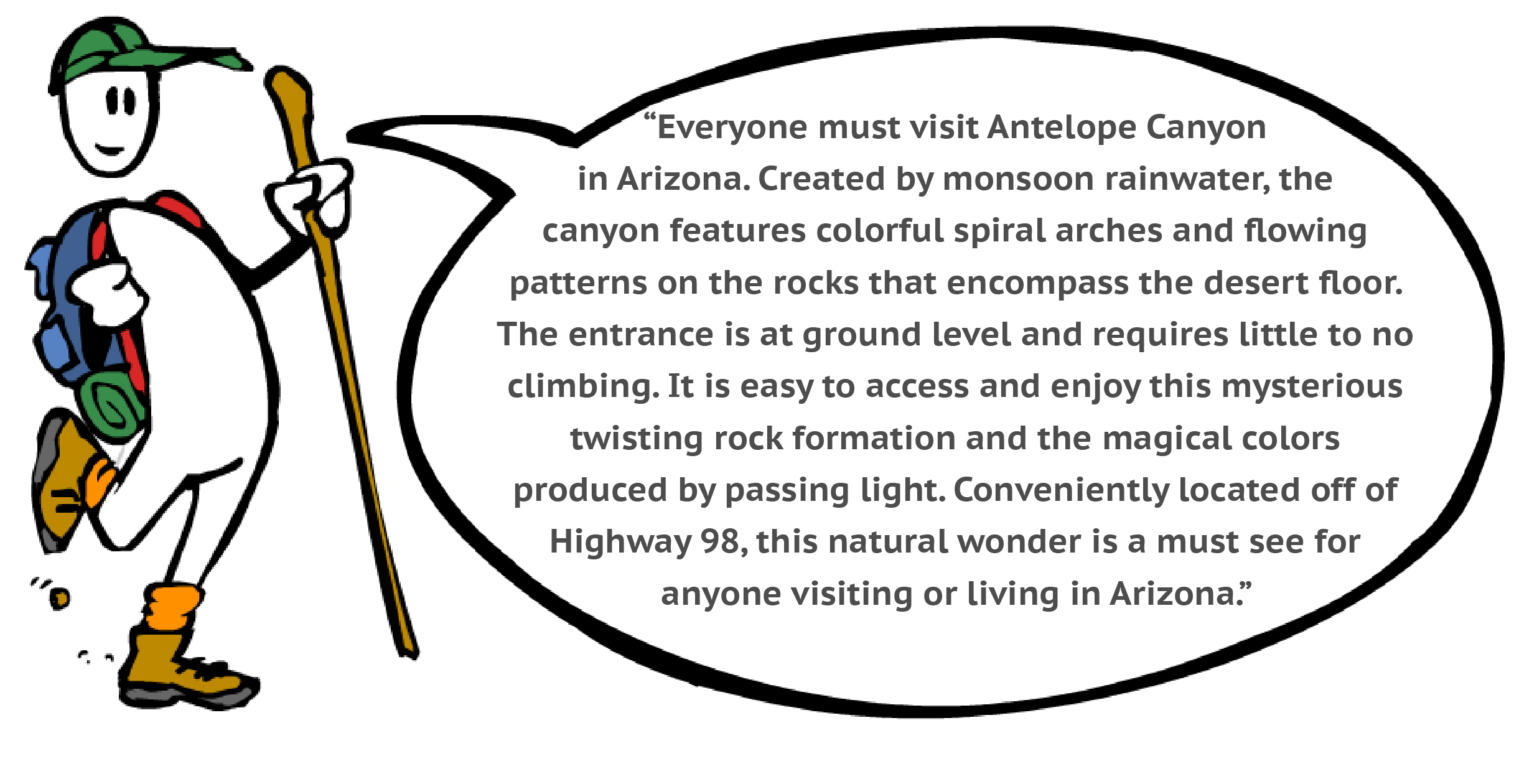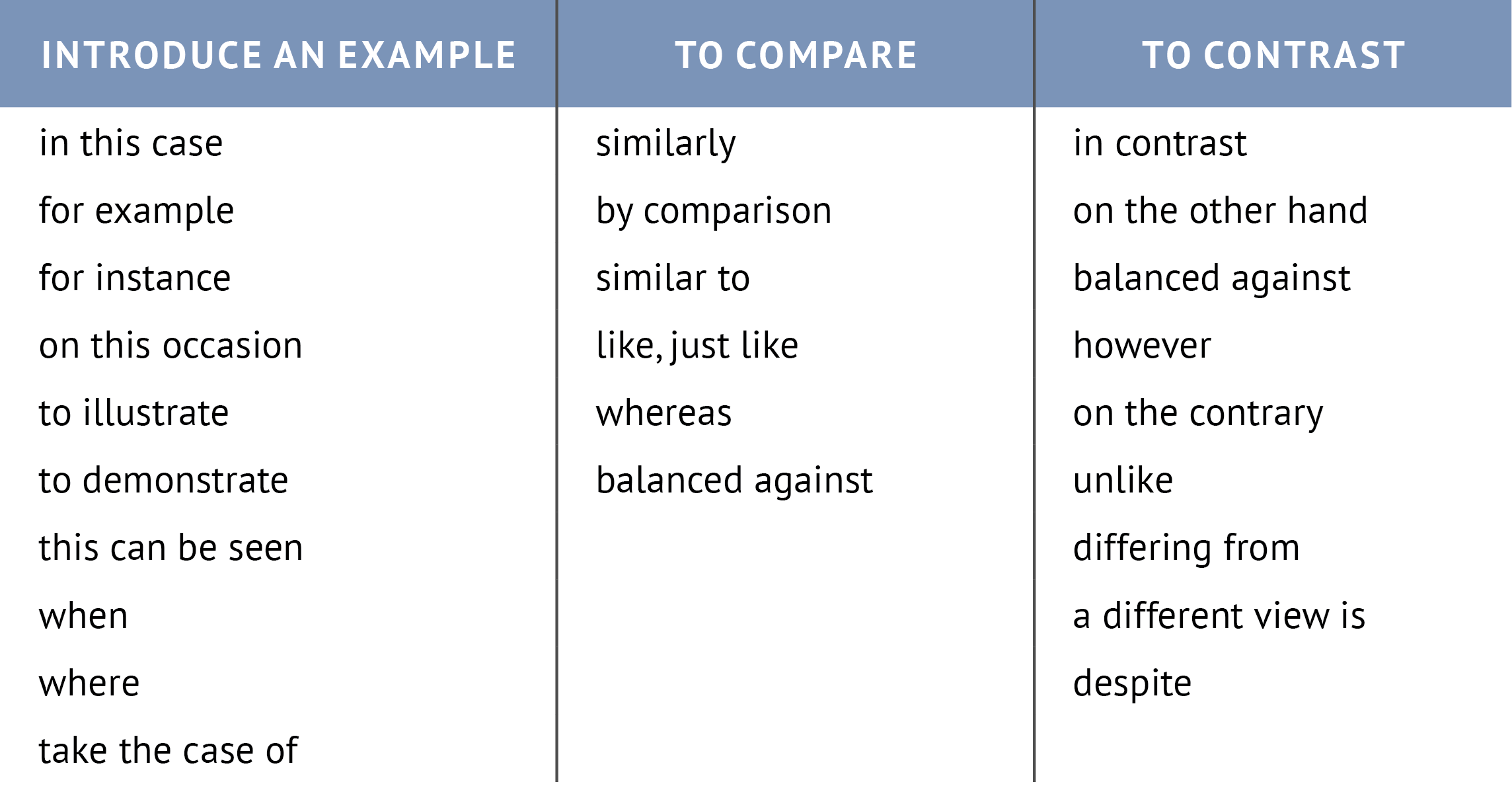
Before you begin reading this chapter, please take this quiz to see what you already know about using examples in your writing.
Introduction
Are you convinced that Antelope Canyon is a place you must visit? You likely have questions such as, “What is Antelope Canyon and what makes it so special?” This is what happens when people make statements without using examples. In the example above, the speaker only makes general statements. Generalizations do not tell your audience anything specific about a topic. Examples are used to illustrate and explain so your ideas are clear to your audience. Consider what information you would want before making a trip to Antelope Canyon. Including such examples would provide the details and illustrations necessary to help you make an informed decision. Now that you have a handle on constructing paragraphs, you are ready to add detailed examples to make your writing come to life. As you gain an understanding of why and how to use examples, you will learn to convey ideas with clarity and coherence. Simple details and observations can make a vague statement clear and coherent to a reader. By the end of this section, you will be able to use examples effectively in all of your writing Purpose of Examples in Academic WritingIf you recommend that someone try the new restaurant in your neighborhood, would you expect that he or she would go if you said nothing about the great prices and delicious food? It is more likely that you would present some details about the restaurant to give your audience a clear understanding of the restaurant’s qualities. The purpose of using examples is not only to illustrate your main ideas, but also to bring clarity and unity to your writing. Examples have several functions, such as:
Understanding ExamplesExamples are used every day to help communicate ideas and opinions. Examples can be used to explain what makes a new restaurant worthwhile or to convey a brilliant new idea to an employer. When you write a review on Yelp or post on Facebook, you use examples to convey your message correctly and effectively. Compare the following reviews of the same restaurant: 
Which review is more convincing? Why? If you were to describe to someone which review is more effective, what examples would you use? In the first example, Sara D. simply states her opinion and provides unnecessary information about the location of the restaurant. This information is not enough for the reader to understand the author’s main idea. However, in the second review, Jennifer R. gives several examples to support the main point. The details she uses help to support her original statement, “I loved Blue Bluffs restaurant!” What are some of the examples Jennifer R. uses to explain her main point about the restaurant?
Types of Examples
There are numerous types of examples, such as vivid imagery, personal experience, pop-culture references, hypothetical scenarios, and research. The trick is to choose the best one to illustrate what you are trying to say. Vivid ImageryIn the example above, details have been added to illustrate why Antelope Canyon is a place worth visiting. With this additional information, are you more likely to think about visiting this site? Why or why not? Vivid imagery, illustrates the majesty and beauty of Antelope Canyon. Using vivid images and details is well suited for describing places, objects, and people. Personal ExperienceHave you ever used your personal experiences, anecdotes, and observations to help someone understand a point or opinion you wish to express? For example, a commuter may believe that taking the bus is faster than taking the light rail. Many may be skeptical. However, the commuter tells you that it took only 1 hour on the bus compared to 3 hours on the light rail to get to work. According to the commuter, the bus is more versatile because it can travel on city streets to many destinations, whereas the light rail has specific stops along a limited path. The bus is more likely to take you closer to your destination than the light rail. This person used personal experience and observations to illustrate the point. Sometimes your relevant observations and experiences can illustrate and explain your main idea successfully. Pop CultureAnother type of example is using references from pop culture. A pop culture example can be anything in the public arena that your audience may know. If you are writing about baseball and your audience consists of baseball fans over 50 years of age, you may reference Shoeless Joe Jackson and the Black Sox scandal to illustrate corruption in sports. However, to use a more current example, you may reference doping and steroid use by professional athletes. HypotheticalA hypothetical example can be used in many situations. A hypothetical example is a contrived or made-up scenario used to illustrate a main idea. When you use a hypothetical, the word “suppose” often is used to introduce the example. If you wish to illustrate how one person might see a situation differently because of differing cultural norms, you might say, “Suppose Yousra is an older male from Morocco, and Sara is a young female from New York City. They both witness the same incident on the subway: A woman grasps another woman's hand as that woman is reaching for a stabilizing bar that five males are holding onto for support. Sara interprets it as one woman trying to help stabilize the other woman, while Yousra sees it as one woman preventing another woman from making a social faux pas. This example clearly shows the audience the difference in perception based on culture and gender. Hypothetical examples work well to explain or help convince a reader of a particular opinion or observation in order to provide depth and clarity to the text. ResearchSometimes you need to research facts, statistics, expert analysis, and relevant experiences to lend support to your main idea. If you wish to lend extra credibility or need specific information to convince and explain your main idea to the audience, you will want to use research. For example, if you wish to take a stance on the side effects of Ritalin, you may want to research statistics showing which side effects are more prevalent and why. This information will tell your audience what the experts have found to be credible and accurate information. Examples of Example Types
Vivid Imagery: Everyone must visit Antelope Canyon, Arizona. Created by monsoon rainwater, the canyon features colorful spiral arches and flowing patterns on the rocks that encompass the desert floor. The entrance is at ground level and requires little to no climbing. It is easy to access and enjoy this mysterious twisting rock formation and the magical colors produced by passing light. Conveniently located off of Highway 98, this natural wonder is a must see for anyone visiting or living in Arizona. Personal Experience: Many people tackle adversity in order to find success. I was born to a drug-addicted parent and was raised primarily in a string of orphanages and foster homes. I made a decision to attend and complete college. I worked numerous part-time jobs, studied every chance I got, and finally reached my goals. Pop Culture: Many people tend to spend more money when they use a debit card than when they use cash. Suze Orman and Dave Ramsey, gurus of frugal living, often say that carrying cash is a great way to curb your spending. Hypothetical: Many people tend to spend more money when they use a debit card than when they use cash. For example, if a person has $20 in cash and an item he or she is thinking of purchasing is $25, he or she is more likely to reconsider the purchase. Research: Many people tend to spend more money when they use a debit card than when they use cash. According to Shannon Simcox (2013), she was much more conscientious of the amount she was spending when using cash. She spent $250 in cash on groceries, while spending over $300 using her card (Simcox, 2013). Choosing and Presenting Examples
Imagery has been added to help provide more examples. Can you picture Antelope Canyon? Have the added details helped you to determine whether this is a place you would want to visit? Each of the types of examples has important characteristics. Examples should utilize vivid images, be relevant and timely, and be specific and detailed. Vivid ImagesDescriptive details paint vivid images of the subject. Descriptive language and details help readers see and understand the ideas being expressed. The description of Antelope Canyon gives an idea of what it looks like and why it is worth seeing. Relevant and TimelyExamples should also be relevant and timely so that the audience can understand the illustration. The earlier reference to Shoeless Joe Jackson would be relevant to baseball fans, but may not be timely. Because the Black Sox incident happened in 1919, a younger audience may not understand the reference. It is always important to consider your audience when you are creating or choosing examples. Specific and DetailedConcrete language and details are used to illustrate the idea or subject. Concrete language refers to objects that actually exist, such as rocks, light, water, or glass. We use these terms to describe subjects that are present or can be compared to something present in the world. Using specific and detailed language to help explain abstract ideas can bring clarity and meaning to your audience. Structure: Incorporating Examples
The last sentence reinforces the reason people should visit this canyon. How does the concluding sentence incorporate the examples used in the paragraph? Think about how the illustration above can be made into a more effective paragraph. You want to make sure you have:
 Placement of Examples
Placement of Examples
Each example is used to illustrate or explain as well as unify ideas. Sometimes an example will further explain a previous example. Both examples should relate to and illustrate the main idea of the paragraph, which is usually expressed in the topic sentence. For example, the first sentence states the canyon is majestic and beautiful. Therefore, a sentence is needed after to provide more details that will support why the canyon is majestic and beautiful. You always want to add detail and explanation for any simple statements you make. If you say that something is good, always explain what makes it good. Signal PhrasesA signal phrase tells the reader what is to come. If you are going to add an example, it often helps to let the reader know what type of example you will be using. For example, the paragraph above about Antelope Canyon uses the signal phrase for instance to let the audience know that a specific example is being presented. If you would like to show comparison in your example, you might use a signal phrase such as similarly or like. If you wish to show a contrast in your example to illustrate your topic, you may use words such as unlike or in contrast. Below is a chart with common signal phrases that can be used to introduce examples and indicate comparison and contrast:  Connection to the Main Point Each example you use should relate to the main point of the paragraph. As seen earlier in the Yelp review, Sara D. stated that she lived down the street from the restaurant; however, she did not explain how that detail was relevant to the point she was making, which was that the restaurant was terrible. If Sara D. had said, “Although the restaurant is conveniently located near my house, the less than satisfactory food and service make even the shortest trip not worth my while," her proximity to the restaurant would have become relevant to her point. 
Examples should illustrate and explain the topic sentence. The purpose of using examples it to make the claim or ideas presented in the topic sentence clear. Critical-Thinking ApplicationsMany different types of writing use examples. Examples are used in our daily communication via email, text, and blogging. Examples also are used in writing for academic and business purposes. In all areas of communication, including various modes of writing, explanation and clarity are essential. College WritingDifferent types of examples often work better in different types of writing. In many cases, hypothetical examples and research work well in academic writing including compare and contrast, and persuasive writing. Professional Writing and Writing as a Global CitizenIn order to communicate in business and to the world, writing is necessary. In your lifetime, you will write business letters, proposals, speeches, and other official or public documents. In all writing, you will need to use examples and explain your ideas clearly and effectively. Personal WritingExamples are used in writing every day. While texting on smartphones is a common form of writing, it is still writing and a way to communicate ideas. Even in a text, you state your ideas and explain what you are trying to say to your audiences on a daily basis. ConclusionExamples are used to illustrate and clarify ideas in all modes of communication every day. When you text, email, or write an academic essay, you should use vivid images, pop-culture references, personal experience, hypothetical scenarios, or research to illustrate and explain your ideas and opinions. No matter the type of writing or example, the characteristics of an example should be timely, relevant, specific, detailed, and vivid. Whether it is a review on a blog or a compare and contrast essay, examples are necessary to bring clarity and coherence to your writing. ReferencesSimcox, S. (2013, June 2). Lessons learned in money exercise. Reading Eagle. Retrieved from http://businessweekly.readingeagle.com/home/ |